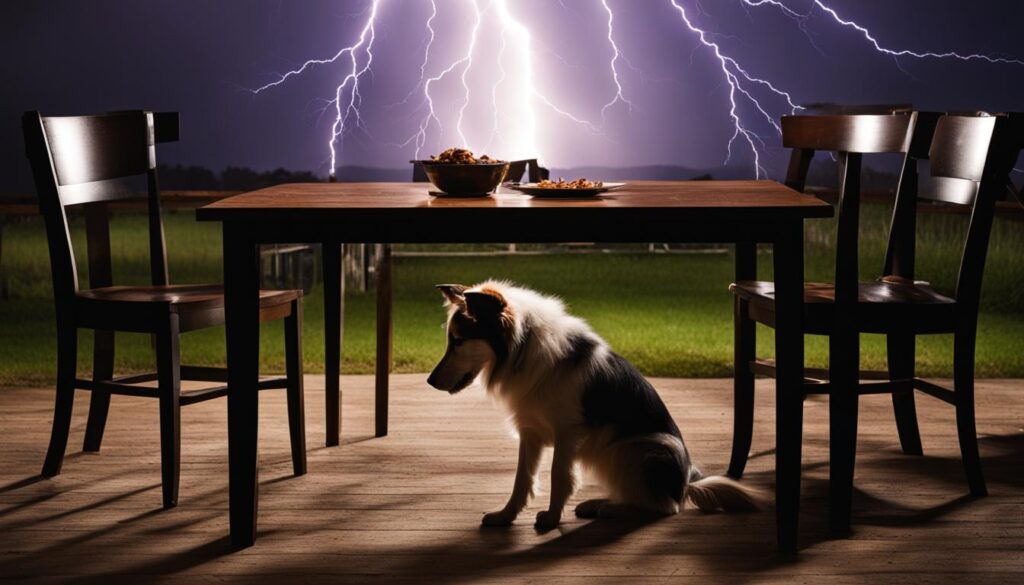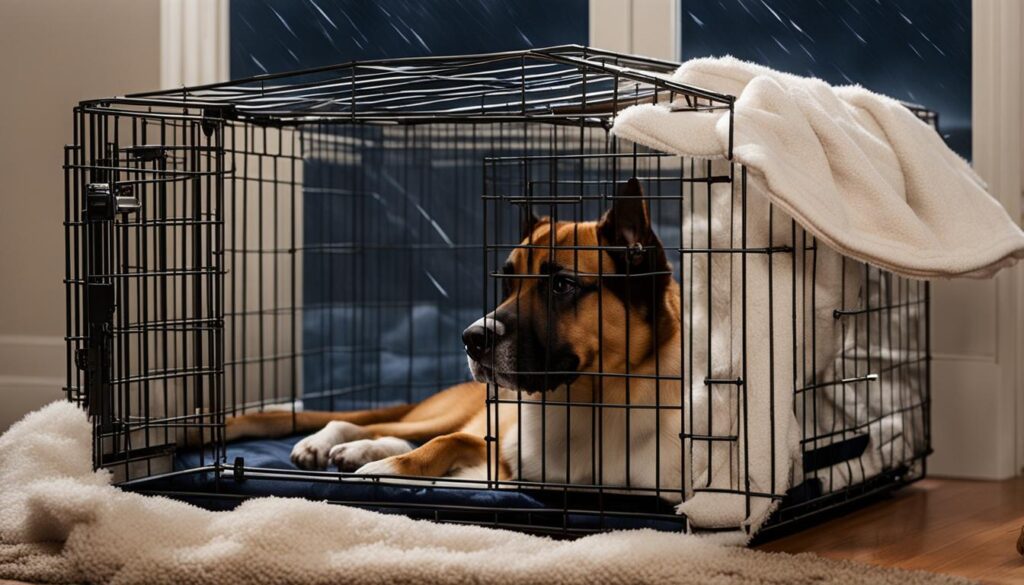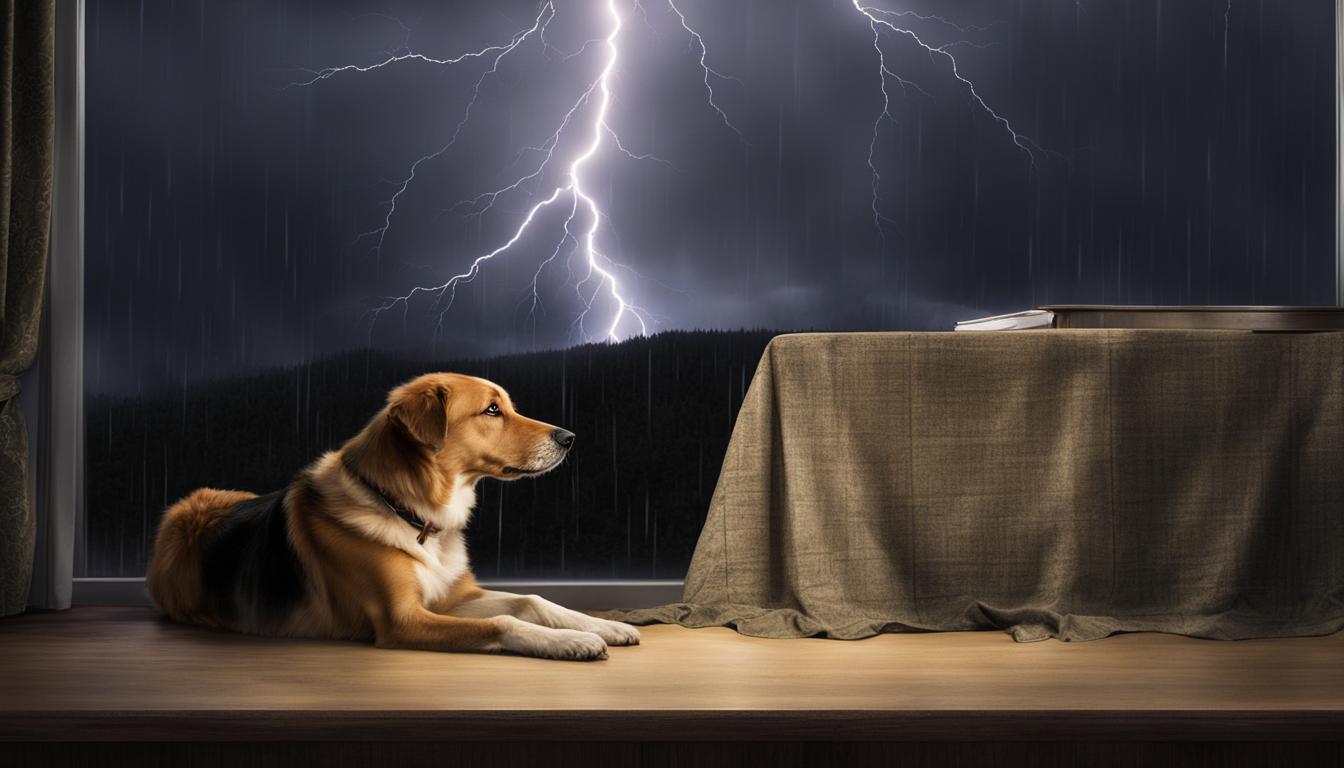Mastering Tips and Tricks for Calming Dogs Afraid of Thunder
Dogs can experience anxiety and fear during thunderstorms, causing them to exhibit behaviors such as shaking, pacing, and trying to hide. It is important for pet owners to understand that comforting their dogs during these moments is not reinforcing fear. Fear is aversive, and petting or offering sympathy will not make the dog more afraid in the future. Instead, it is essential to provide a calm and secure environment for the dog during thunderstorms.
Key Takeaways
- Coping with dog thunder phobia requires a combination of understanding, patience, and techniques tailored to each individual dog.
- Comforting a fearful dog during a storm provides comfort and reassurance, rather than reinforcing fear.
- Creating a safe and secure environment by blocking out sights and sounds can help alleviate anxiety in dogs.
- Seeking professional help may be necessary for dogs with severe storm phobias.
- Long-term strategies, such as relaxation training and desensitization, can help dogs overcome their fear of thunderstorms.
Understanding Storm Phobias in Dogs
Dogs can develop storm phobias or fear of thunderstorms due to their ability to sense changes in barometric pressure. These phobias can lead to behaviors such as excessive pacing, licking, and attempting to escape or hide. As pack animals, dogs look to their owners for guidance and assurance during uncertain times. Maintaining a calm attitude during storms can help alleviate anxiety in dogs. Fussing over a fearful dog may reinforce their anxiety, so it is important to remain calm and provide a sense of security.
Signs of anxiety in dogs during storms can vary but often include trembling, panting, drooling, and seeking shelter. It is important to observe these behaviors and provide appropriate guidance as a pack leader. By staying calm and confident, you can help your dog feel more secure and less anxious during thunderstorms.
Remember that dogs take cues from their owners, so if you are anxious or fearful during a storm, your dog may pick up on that energy and become even more anxious. By projecting a calm and assertive energy, you can help your dog feel safer and more confident during stormy weather.
Table: Signs of Anxiety in Dogs During Storms
| Signs of Anxiety | Description |
|---|---|
| Trembling | Dog shakes uncontrollably and may have difficulty standing or walking. |
| Panting | Rapid and excessive breathing, often with an open mouth. |
| Drooling | Excessive saliva production, resulting in a noticeable drool. |
| Seeking Shelter | Dog tries to find a hiding place or seeks comfort from their owner. |
Understanding storm phobias in dogs and providing pack leader guidance during storms can greatly help alleviate their anxiety. By remaining calm, projecting confidence, and providing a secure environment, you can help your dog feel safer and less fearful during thunderstorms.

Creating a Safe Environment for Dogs During Thunderstorms
Dogs can experience intense fear and anxiety during thunderstorms, and it is crucial for pet owners to create a safe and secure environment to help calm their storm-phobic dogs. Here are some effective strategies:
1. Crate Training
Crate training can provide a den-like environment for dogs and make them feel safe during storms. Introduce the crate gradually, making it a positive and comfortable space. During thunderstorms, place the dog in the crate with a cozy blanket and some toys to divert their attention from the storm. Remember to keep the door unlocked to avoid any panic if they want to leave the crate.
2. Blocking Out Thunder and Lightning
Minimize the sights and sounds of thunder and lightning by closing doors, windows, and curtains. This can help create a more peaceful environment for your dog. Additionally, consider using white noise machines or playing calming music at a moderate volume to mask the storm sounds and provide a soothing atmosphere.
3. Diverting Attention from Storms
Engaging your dog in activities or offering their favorite treats can divert their attention from the storm. For example, you can play interactive games or give them food puzzles to keep them mentally stimulated. Distraction can help alleviate their anxiety and provide a sense of security during thunderstorms.
| Safe Environment Strategies | Benefits |
|---|---|
| Crate Training | Provides a secure and den-like space |
| Blocking Out Thunder and Lightning | Reduces visual and auditory stimuli |
| Diverting Attention from Storms | Keeps the dog's focus away from the storm |
By implementing these strategies, you can create a safe and calming environment for your dog during thunderstorms. Remember, every dog is unique, so it may take time to find the most effective approach for your furry friend. If your dog's storm phobia persists or worsens, consider consulting with a professional dog behaviorist or veterinarian for additional guidance and support.

Seeking Professional Help for Dogs with Severe Storm Phobias
In some cases, dogs with severe storm phobias may require professional assistance to manage their anxiety. Desensitization techniques can be highly effective in helping dogs become less fearful of thunderstorms. This approach involves gradually exposing the dog to storm-related stimuli, such as playing storm sounds at a low volume and gradually increasing the intensity over time. By pairing these stimuli with positive experiences and rewards, dogs can learn to associate storms with more positive feelings.
Calming products can also provide relief for thunder-fearful dogs. Products like ThunderShirts, which use gentle pressure to create a sense of security, can help dogs feel more grounded during storms. Natural remedies, such as herbal supplements or pheromone diffusers like Adaptil, may also be worth considering. These products can help promote relaxation and reduce anxiety in dogs.
However, for dogs with severe storm phobias that do not respond to these techniques and products, medication prescribed by a veterinarian may be necessary. Medications like anti-anxiety drugs or antidepressants can help dogs manage their anxiety during thunderstorms. It is important to consult with a professional who can assess the individual dog's needs and prescribe the most appropriate course of treatment.
To summarize, seeking professional help for dogs with severe storm phobias can provide effective solutions for managing their anxiety. Desensitization techniques, calming products, and medication prescribed by a veterinarian are all viable options to consider. By addressing the underlying causes of their fear and implementing appropriate interventions, pet owners can help their dogs find relief and feel more secure during thunderstorms.
Acute Management Strategies for Dogs during Thunderstorms
During thunderstorms, it is crucial to create a safe and secure environment for dogs to help them cope with their fear and anxiety. Here are some strategies that can be beneficial:
Avoiding Punishment for Fearful Behavior
Punishing a fearful dog during a thunderstorm can worsen their distress and anxiety. Instead, it is important to remain calm and provide reassurance. Punishment can lead to further fear and can have long-lasting negative effects on the dog's mental well-being. By avoiding punishment and focusing on positive reinforcement, we can help the dog associate thunderstorms with positive experiences.
Creating a Safe and Secure Environment
Providing a safe and secure environment is crucial during thunderstorms. This can involve creating a darkened room where the dog feels safe, using eye covers or blinds to block out flashes of lightning, and playing calming music or white noise to mask the sound of thunder. These measures can help reduce the dog's exposure to the stimuli that trigger their fear and provide a sense of security.
Using Positive Reinforcement
Positive reinforcement is an effective technique for managing fear and anxiety in dogs. During thunderstorms, engaging in activities that the dog enjoys, such as playing games or offering treats, can help distract them from their fear and create positive associations with the stormy environment. Using a calm and soothing voice while interacting with the dog can also help them feel more secure and reduce their anxiety.
By implementing these acute management strategies, we can create a calm and supportive environment for dogs during thunderstorms. Remember to be patient and understanding, as each dog may respond differently. If the dog's fear and anxiety persist or worsen, it is important to seek professional help to develop a comprehensive long-term plan for managing their storm phobias.
Long-Term Strategies for Helping Dogs with Storm Phobias
When it comes to helping dogs overcome their storm phobias, long-term strategies focused on training and desensitization can be highly effective. By teaching dogs to relax on command and gradually exposing them to storm-related stimuli, we can help them build resilience and reduce their fear response. Here are some key strategies to consider:
Training Dogs to Relax on Command
One of the most valuable skills we can teach our dogs is how to relax on command. This can be achieved through positive reinforcement techniques, such as rewarding calm behavior and using relaxation cues like “settle” or “easy.” By practicing relaxation exercises in various locations and situations where the dog feels comfortable, we can help them associate relaxation with different environments, including during thunderstorms.
Desensitization to Storm Stimuli
Desensitization involves gradually exposing dogs to the stimuli associated with thunderstorms at a low level and rewarding them for remaining calm. This can be done through the use of recorded storm sounds played at a barely audible volume, and then gradually increasing the volume over time. The aim is to help the dog associate the previously anxiety-inducing stimuli with positive experiences, gradually reducing their fear response.
Using a “Happy Voice” and Relaxed Body Postures
During storm-related interactions with our dogs, it is essential to maintain a calm and relaxed demeanor. By using a “happy voice” characterized by a soothing tone, we can help convey a sense of safety and reassurance to our dogs. Additionally, our body language should be relaxed, avoiding tense or anxious postures that might further contribute to their anxiety.
Remember, every dog is unique, and it may take time and patience to see progress. It is crucial to tailor these strategies to fit your dog's specific needs and consult with a professional trainer or behaviorist if necessary. With consistent training and a supportive environment, you can help your dog overcome their storm phobias and live a happier, more relaxed life.
Additional Treatment Options for Dogs with Storm Phobias
When it comes to helping dogs with severe storm phobias, there are additional treatment options available that can provide relief and support. These options include drug therapy, DAP (Dog Appeasing Pheromone), and covers and wraps designed specifically for anxiety relief in dogs.
Drug therapy can be prescribed by a veterinarian to help control anxiety and decrease the intensity of the dog's response to storms. Medications such as Clomipramine or Xanax may be recommended based on the individual dog's needs and severity of the phobia. It is important to consult with a veterinarian to determine the most suitable medication and dosage for each dog.
DAP, or Dog Appeasing Pheromone, is a synthetic version of a pheromone that helps to calm and comfort dogs. It can be used in the form of diffusers, sprays, or collars. DAP mimics the pheromone released by mother dogs while nursing their puppies, creating a sense of security and relaxation for dogs experiencing anxiety during thunderstorms.
In addition to drug therapy and DAP, there are covers and wraps available that can provide anxiety relief for dogs. Products such as Thundershirts or Storm Defenders apply gentle, constant pressure to the dog's body, creating a swaddling effect that can help reduce anxiety and promote a sense of security. These products are designed to be snug but not restrictive, providing comfort during storms.
Table: Comparison of Additional Treatment Options
| Treatment Option | Method of Administration | Benefits |
|---|---|---|
| Drug Therapy | Prescription medication | Controls anxiety and reduces response intensity |
| DAP (Dog Appeasing Pheromone) | Diffusers, sprays, or collars | Calms and comforts dogs with synthetic pheromone |
| Covers and Wraps | Thundershirts or Storm Defenders | Provides gentle, constant pressure for anxiety relief |
References and Resources for Dog Owners
If you're a dog owner struggling to help your furry friend cope with storm phobias, there are various resources available to assist you. These references and materials can provide valuable insights and guidance on managing your dog's anxiety during thunderstorms. Below, we have compiled a list of recommended books, articles, and medications that can help you navigate this challenging situation.
Books and Articles about Helping Dogs with Fears
There are several informative books available that delve into the topic of helping dogs overcome their fears and anxieties. One highly recommended book is “The Cautious Canine” by Patricia B. McConnell, which provides practical tips and strategies for understanding and addressing fear-based behavior in dogs. Additionally, reputable magazines like Bark Magazine and APDT Chronicle often feature articles written by experienced dog behavior specialists, offering valuable insights and advice for managing storm phobias in dogs.
Recommended Medications for Storm Phobias in Dogs
In some cases, medications may be necessary to help alleviate your dog's severe storm phobias. It is crucial to consult with a veterinarian to determine the most suitable medication for your dog's specific needs. Some commonly prescribed medications include Clomipramine and Xanax, which can help control anxiety and reduce the intensity of your dog's response to thunderstorms. Remember, medication should always be administered under the guidance and supervision of a qualified veterinary professional.
| Resources | Categories |
|---|---|
| Book: “The Cautious Canine” by Patricia B. McConnell | Helping Dogs with Fears |
| Bark Magazine | Articles about Helping Dogs with Fears |
| APDT Chronicle | Articles about Helping Dogs with Fears |
| Clomipramine | Recommended Medications for Storm Phobias in Dogs |
| Xanax | Recommended Medications for Storm Phobias in Dogs |
By referring to these resources and consulting with professionals, you can gain valuable knowledge and find effective strategies to help your storm-phobic dog. Remember, every dog is unique, so it may take time and patience to find the right approach that works for your furry companion. With proper support and understanding, you can create a safe and comforting environment to help your dog feel more secure during thunderstorms.
Conclusion
Calming dogs afraid of thunder requires a combination of understanding, patience, and techniques tailored to each individual dog. By implementing the tips and tricks mentioned in this article, you can help your furry friend cope with storm phobias and find peace during thunderstorms.
It is important to provide a calm and secure environment for your dog during storms. Create a safe space using a crate or a darkened room and block out the sights and sounds of thunder and lightning. Distract your dog's attention with activities or favorite treats, and consider using calming products or natural remedies to reduce anxiety.
If your dog continues to struggle with storm phobias, seeking professional help is recommended. Desensitization techniques, medication, or other treatment options may be necessary to alleviate severe anxiety. Remember to remain calm and provide reassurance to your dog, using positive reinforcement instead of punishment.
With the right approach and resources, you can help your dog overcome their fear of thunder and create a peaceful environment for both of you during stormy weather. Remember, comforting a fearful dog during a storm does not reinforce fear, but rather provides comfort and reassurance.
FAQ
Can comforting my dog during a thunderstorm reinforce fear?
No, comforting your dog during a thunderstorm does not reinforce fear. Fear is aversive, and petting or offering sympathy will not make the dog more afraid in the future. Instead, providing a calm and secure environment can help alleviate anxiety.
How can I create a safe environment for my dog during thunderstorms?
You can create a safe environment for your dog during thunderstorms by crate training them, closing doors, windows, and curtains to block out sights and sounds, and playing a radio or TV at a higher volume to drown out storm noises. Diverting their attention to activities or favorite treats can also provide a sense of security.
What should I do if my dog continues to struggle with storm phobias?
If your dog continues to struggle with storm phobias, it is recommended to seek professional help. Desensitization techniques, calming products, and natural remedies can be helpful. In severe cases, medication prescribed by a veterinarian may be necessary.
How can I manage my dog’s anxiety during thunderstorms?
To manage your dog's anxiety during thunderstorms, create a safe and secure environment by providing a darkened room, using eye covers, and playing music or white noise to muffle outside sounds. Avoid punishment and use positive reinforcement, such as long smooth strokes or engaging in games, to help distract and calm your dog.
What are some long-term strategies for helping dogs with storm phobias?
Some long-term strategies for helping dogs with storm phobias include teaching them to relax on command in various comfortable situations, using desensitization techniques by gradually exposing them to storm stimuli, and using a “happy voice” and relaxed body postures to convey non-threat. Avoid reinforcing inappropriate responses and negative actions.
Are there additional treatment options for dogs with severe storm phobias?
Yes, there are additional treatment options such as drug therapy, including medications like Clomipramine or Xanax to control anxiety, and using DAP (Dog Appeasing Pheromone) to help calm anxious dogs. Covers and wraps like Thundershirts or Storm Defenders can also provide anxiety relief, although their success may vary.
Where can I find references and resources for helping dogs with storm phobias?
You can refer to books like “The Cautious Canine” and articles in magazines like Bark Magazine and APDT Chronicle. Storm desensitization DVDs and calming products like Adaptil and Storm Stress can also be beneficial. Consult with a veterinarian or dog behavioral specialist for specific recommendations and medications.
How can I help my dog cope with storm phobias?
Helping your dog cope with storm phobias requires understanding, patience, and tailored techniques. Providing a calm and secure environment, using positive reinforcement, and seeking professional help when needed can all contribute to helping dogs cope with storm phobias. Comforting a fearful dog during a storm provides reassurance and does not reinforce fear.
Source Links
- https://www.patriciamcconnell.com/theotherendoftheleash/you-cant-reinforce-fear-dogs-and-thunderstorms
- https://www.quakershillvethospital.com.au/cats/storm-and-firework-anxiety/
- https://jordandogtraining.com.au/resources/dog-training-tips/dealing-storm-phobia-dogs/











Leave a Reply